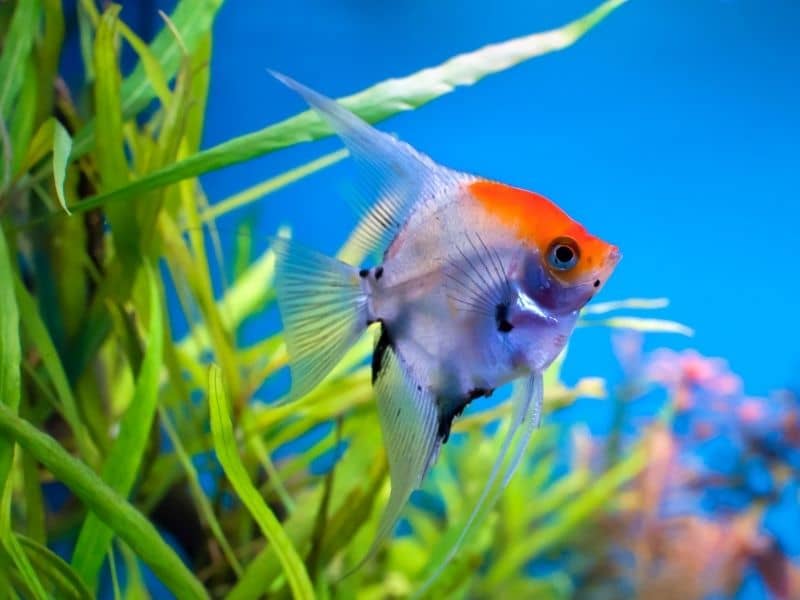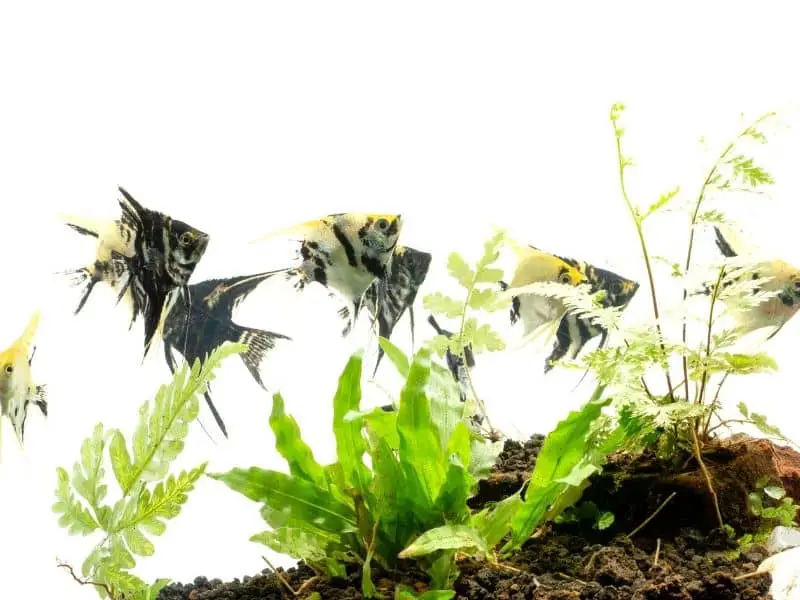Perhaps the most popular cichlid species in the aquarium trade is Angelfish. They come in a wide variety of colors and patterns and are known for their relative ease of care.
However, angelfish can also be quite aggressive, especially when they are kept in groups. If you’re not careful, your angelfish may start attacking each other and even other fish.
Why do they become aggressive even though they are known as peaceful fish? And how to calm down angelfish? We’ll go over all of that here.

Why are my angelfish so aggressive?
Jump To
Compared with other cichlid species, Angelfish are quite peaceful species that will do exceptionally well with other fish. However, they will become aggressive for several reasons.
- Establishing dominance
- Small tank
- Overcrowded tank
- Incompatible tankmates
- Lack of food
- Spawning and breeding
Let’s discuss each of these reasons in more detail.
01. Establishing dominance
Angelfish become aggressive as a way of establishing dominance over their tankmates. This aggression is often seen in aquariums when two or more angelfish are kept together.
When kept together, they will fight for dominance and the hierarchy of the group. This can lead to nipping, chasing, and even killing other fish.
It’s important to understand that aggression is a natural part of an angelfish’s behavior.
They are territorial fish that will defend their space from other angelfish in the wild. So, if you see your angelfish being aggressive, it’s not necessarily a bad thing.
However, there are some cases where the aggression can get out of hand and become a problem. If your angelfish are constantly fighting and you see injuries, then it’s time to take action.
02. Small tank
Another reason why your angelfish may be aggressive is that they are kept in a small tank.
Angelfish are large fish, and they need plenty of space to swim. A small tank will cause them to feel cramped and stressed, which can lead to aggression.
If your tank has limited space to explore, you will see your fish become more aggressive. They will have a hard time exploring around with more conflicts.
You will also experience the tank becoming dirty quicker with high aggression levels in your angelfish.
The minimum recommended size of an angelfish tank is 20 gallons. If your tank is smaller than that, you will often see your angelfish fighting with each other.
03. Overcrowded tank
An overcrowded tank is another common cause of aggression in angelfish.
When there are too many fish in a tank, it can lead to fighting and aggression. This is because the fish are competing for space, food, and other resources.
If your tank is overcrowded, you will see that some of your fish become aggressive and bully other fish. The tank will get dirtier quicker, and the fish will be more stressed.
Eventually, some fish (especially smaller fish) will start to die off. So, it’s important to avoid overcrowding your tank if you want to keep your fish healthy and happy.
04. Incompatible tankmates
Even with perfect tank conditions and a large enough tank, your angelfish can become aggressive if they are kept with incompatible tankmates.
This is because each fish species has its own unique set of behaviors and needs. So, it’s important to do your research before adding any fish to your tank.
Some fish species are known to be compatible with angelfish, while others are not. Incompatible fish will often trigger aggression in your angelfish.
Some examples of incompatible fish species include:
- Tiny fish like small tetras, guppies, and mollies (Angelfish often see them as snacks)
- Shrimps (all species) (Will eat them)
- Fin nippers like barbs and bettas (They tend to nip at Angelfish, which can lead to injury and aggression)
- Slow-moving fish like goldfish (They can’t compete for food)
If you observe your angelfish are attacking other tankmates, they are likely incompatible. In this case, you will have to remove the incompatible fish from the tank to avoid further aggression.
Read More : Can Angelfish Live With Mollies? ( Yes !! )
05. Lack of food
Angelfish are quite peaceful when they are kept in a large enough tank with compatible tankmates. However, they can become aggressive if they are not getting enough food.
When angelfish are hungry, they will become more aggressive and start to chase other fish. This is because they are trying to get food from the other fish.
This aggression arises when you feed your fish. So, if your angelfish goes into the attacking mode during feeding time, it’s likely that they are not getting enough food.
06. Spawning and breeding
Angelfish can become aggressive when they are spawning or breeding. This is because they are trying to protect their eggs from other fish.
Angelfish are known to be good parents and will often attack other fish that come close to their eggs. They become territorial during this time and even attack their pairing mate if they see them as a threat.
This is why most aquarists recommend removing other fish from the tank when your angelfish are spawning. This will help to avoid any aggression and allow your angelfish to focus on breeding.

What to do with an aggressive angelfish?
Seeing an aggressive angelfish might surprise you because they are usually peaceful fish. However, you can reduce their aggression by following some steps.
When you observe an aggressive angelfish, the first thing you should do is find the cause for it. Once you find the root cause, you can work on fixing it.
Fixing the root cause will help you calm down your fish most of the time.
But, sometimes, you will have no other option than to remove the aggressor. In this case, you can keep the aggressive fish in a separate tank or sell it off.
If you want to keep the fish together, you can try to socialize them. This process will help the fish get used to each other and reduce their aggression.
How to calm down my angelfish?
To calm down your aggressive angelfish, you will have to work on the root cause of their aggression. Once you find the root cause, you can work on fixing it.
For this, you can try doing one or several of the following things:
01. Provide a large aquarium
If your angelfish act aggressively because of the lack of space, you can provide them with a larger aquarium. This will give them more room to move around and reduce their aggression.
The minimum tank size we recommend for one Angelfish is 20 gallons. If the tank is taller, that would be better because these fish have a laterally compressed tall body. Each additional fish require a minimum of 10 gallons more.
So, if you have two angelfish, the minimum tank size should be 30 gallons. For three fish, it should be 40 gallons, and so on.
02. Provide hiding spots
Hiding spots are essential for all fish, but they are especially important for angelfish. This is because these fish are known to be shy and need places to hide when they feel scared or threatened.
You can provide hiding spots for your angelfish by adding plants, caves, or other decorations to the tank. This will give them places to hide when they feel scared or threatened.
03. Provide compatible tankmates
If your angelfish are aggressive because they are incompatible with their tankmates, you can remove the incompatible tankmates and provide them with compatible tankmates. This will help to reduce their aggression.
Some compatible tankmates for angelfish include:
- Gouramis
- Catfish
- Danios
- Rasboras
- Loaches
- Corydoras
- Platies
- Swordtails
- Mollies
04. Provide enough food
If your angelfish are aggressive because they are hungry, you can provide them with enough food. This will help to reduce their aggression.
When feeding your Angelfish, you should give them a variety of foods. This will help to ensure that they are getting all the nutrients they need.
Some good foods for angelfish include:
- Bloodworms
- Brine shrimp
- Daphnia
- Krill
- Mysis shrimp
- Plankton
05. Provide lots of vegetation
Some angelfish become aggressive when the water is not clean and when they don’t have enough places to hide.
Adding some live plants will solve both problems by providing your angelfish with places to hide and by helping to keep the water clean.
06. Do fewer water changes
You might be surprised at this as most fish species prefer fresh, cleaner water in their surroundings. But, in the case of angelfish, too many water changes can make them aggressive.
This is because angelfish are very sensitive to changes in their environment. They use chemical signals such as urine and bile they release to establish their social hierarchy in the tank. Once established, they become calm and relaxed.
But, when you do a water change, it removes these chemical signals, and the angelfish have to re-establish their social hierarchy. This process can be stressful for them and make them aggressive.
So, if you are doing water changes too often, it might be the reason why your angelfish are aggressive. Try doing water changes once a week or every two weeks and see if it makes a difference.
Some angelfish remain aggressive and hurt others even after doing all the steps above. This is something that rarely happens, but do not worry. There are some steps you can take to socialize with your aggressive fish.
Step 1
Remove the aggressive fish into a separate tank
Aggressive fish keep bullying other fish because they want to show their dominance around. Once you remove them from the tank, the other fish will feel more comfortable and relaxed.
Further, your other fish will re-establish their social hierarchy without the aggressive fish. In the meantime, the aggressive fish will have no one to bully and will have to establish their own social hierarchy.
Step 2
Keep the fish separated for about 2 to 4 weeks
You should keep the aggressive fish in a separate tank for about 2 to 4 weeks. This will give them time to establish their social hierarchy and become used to being alone.
Step 3
Add the fish back into the tank one at a time
After 2 to 4 weeks, you can add the fish back into the tank one at a time. This will help to reduce the stress on the fish and make it easier for them to re-establish their social hierarchy.
You should also keep a close eye on the fish when you add them back into the tank, as they might start fighting again.
Important: If your aggressive fish start to fight again, then you will have no choice but to remove them and keep them in a separate tank.
Conclusion
Angelfish are beautiful fish that make a great addition to any aquarium. But, they can be aggressive and might hurt other fish in the tank.
To prevent this from happening, you should do a few things:
- Provide a large aquarium
- Provide enough hiding spaces
- Provide compatible tankmates
- Provide enough food
- Provide lots of vegetation
- Do fewer water changes
By following the above steps, you can calm down your angelfish. If your angelfish are still aggressive, you can try socializing them by removing them from the tank and adding them back one at a time.
If socializing doesn’t work, then you might have to keep them in a separate tank.
Do you have an aggressive angelfish? How do you deal with it? Let me know in the comments below.
Read Next : Sea Robin Fish Care | A Fish With Legs And Wings |
